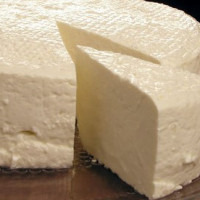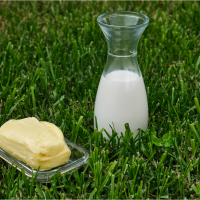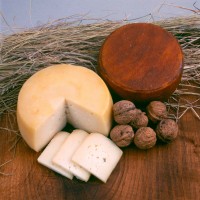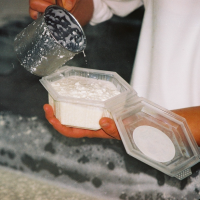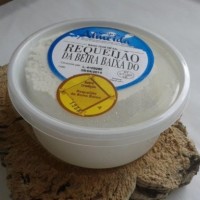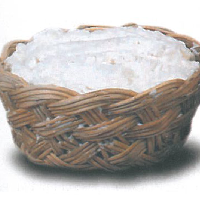Requeijão da Madeira it´s presented as a fresh product whose mass, not pressed, can be molded in cotton towels to form a “bread” or “ball” locally called “pão de requeijão”, which can have several kilograms of weight (less than 10 kg) and are packed in sealed plastic bags.
It can also be self-moulded in moulds or multi-mold plates for draining the “sorelho” and later packaging in individual packages of different capacities (between 100 g and 500 g), also sealed.
Description: “Manteiga dos Açores” means butter obtained exclusively from pasteurized cream from cow's milk, with or without the addition of salt. It is not allowed the use of reconstituted milk. “Manteiga dos Açores” is characterized by being a product:
- Without any addition of lactic ferments, food coloring or preservatives,
- Betacarotene ≥5 mg values KOH / g (liquid chromatography method with high efficiency);
- Intense color, aroma and flavor marked by a fresh and dairy taste.
Descrição: O queijo fresco de cabra é produzido a partir de leite de cabra estreme, submetido a tratamento térmico e coagulado com coalho animal. Tem uma forma cilíndrica e um peso inferior a 150 g. O queijo seco é obtido a partir do queijo fresco não comercializado, procedendo-se à sua salga, por deposição de uma camada de sal à superfície do queijo, sendo depois sujeito a um processo de secagem à temperatura ambiente. Tem uma forma idêntica à já descrita para o queijo fresco e um peso de cerca de 100 g. O queijo curado é de pasta semidura a dura, tem forma cilíndrica e variam o peso e dimensões com que é comercializado, embora raramente ultrapasse 12 cm de diâmetro, 4 cm de altura e 1 kg de peso. O aspeto da crosta é variável, sendo normalmente as faces e os bordos planos ou ligeiramente irregulares e as arestas marcadas. A pasta é firme, fechada ou com pequenos olhos irregularmente distribuídos, e a sua cor branca ou ligeiramente amarelada. O sabor e o aroma são característicos, evitando-se que tenha um sabor acentuado a leite de cabra.
Description: Requeijão da Beira Baixa PDO is produced through the precipitation or coagulation, by heating, of the lactoalbumin and lactoglobulin in the whey obtained as a by-product of the manufacturing of ‘Queijos da Beira Baixa’ (Queijo de Castelo Branco, Queijo Amarelo da Beira Baixa, Queijo Picante da Beira Baixa) DOP and is obtained in the specified geographical area. It is presented as a fresh, unfermented product, with a soft consistency, more or less like a paste, which is a result of incorporating some of the serum.
Description: Requeijão da Beira Baixa PDO is produced through the precipitation or coagulation, by heating, of the lactoalbumin and lactoglobulin in the whey obtained as a by-product of the manufacturing of Queijos da Beira Baixa (Queijo de Castelo Branco, Queijo Amarelo da Beira Baixa, Queijo Picante da Beira Baixa) DOP and is obtained in the specified geographical area. It is presented as a fresh, unfermented product.
Description: Requeijão Serra da Estrela PDO is the product obtained by precipitation or coagulation by heat of the proteins contained in the whey resulting from the manufacture of Serra da Estrela cheese PDO. Raw milk obtained from sheep of the breeds Bordaleira Serra da Estrela and Churra Mondegueira, drinking water and occasionally, in very special and duly authorised circumstances, milk from goats of the Serrana or Jarmelista varieties of the Serrana breed may be added to the whey. Requeijão Serra da Estrela PDO takes the form of a creamy and slightly lumpy mellow and uniform white mass. It is moulded by its container (roughly a cylinder with an irregular base) and weighs between 150 and 400 grams per piece. It is consistent, uniformly creamy, easy to cut and white in colour. The taste and odour are agreeable and it melts in the mouth.



